The missing mace
Examine the clues in one of Victoria's most daring thefts. Can you solve the case?

On Friday, 9 October 1891, a daring theft was reported. The parliamentary mace, symbol of the Speaker’s authority in the Legislative Assembly, had been stolen from Parliament House. To this day it has not been found.
Who was the thief? And how could a five-foot long mace, overlaid with gold, go missing without a trace? Let’s examine the clues ...
On this page
The crime scene
The Legislative Assembly’s mace was last seen in the early hours of Friday, 9 October. The Assembly sitting finished at 12.40 am, and the Serjeant-at-Arms carried the mace to the Speaker’s rooms, locking it in a custom-built oak case.
At 1.00 pm that afternoon, doorkeeper Frederick Davis noticed strange marks had appeared on the mace’s case. It looked like a chisel or screwdriver had been used to pry the box open, damaging the locks.
When the case was opened, it was discovered that the mace was gone.
The stolen mace
In the Parliament of Victoria, a mace symbolises the power of the Speaker. This is the person who keeps order in the Legislative Assembly Chamber. When the Assembly is meeting, the mace is placed on the central table.
The stolen mace was around five-feet long. Made of silver, with only a thin overlay of gold, it could be broken up into ten separate pieces. It was topped by a large crown and engraved with the English and Victorian coats of arms.
The public widely believed that the mace was extremely valuable. In fact it was relatively worthless, costing the Parliament less than £300. It would have been easier, and more profitable, for a thief to steal the silverware and plates kept in the Speaker’s room.

Suspect #1: the parliamentary engineer
A 12.53 pm on 9 October a man was seen running from Parliament House. He was carrying a five-foot long package wrapped in brown paper. As the man boarded a tram, the package accidentally struck a metal rail and made a clanging noise. He was later identified as Thomas Jeffery, the parliamentary engineer.
Jeffery said that the package contained discarded wood, zinc and wire. He often collected scraps from Parliament House to use in his workshop. He said he could not remember the day exactly, but he may have boarded the tram to check on his ill wife at their home in Abbotsford. He had been seen at Parliament House at 1.30 pm, giving him just enough time for the journey there and back.
The police searched Jeffery’s home, but could find no evidence. There also seemed to be no motive. Working at Parliament House for 24 years, Jeffery knew the mace was not valuable. He also knew that the mace could be broken into pieces. In fact it was his job to take it apart when requested. So why would he carry it out of Parliament House in such a large and suspicious package?
Jeffery was never charged, though he remained the police’s top suspect.

Suspect #2: an unnamed builder
The Speaker’s rooms had just one window, which had been left open on the morning of 9 October. The window overlooked the construction of the new north wing basement. Could a builder have used his ladder to climb through the open window, and then pried open the mace’s case with his tools? Police were excited to find three grimy fingerprints on the inside of the windowsill, but they could not be identified.
Suspect #3: a drunken prankster
Satirical magazine The Punch claimed that a heavy-drinking member of Parliament had taken the mace. It was said that this member had been drunk and hidden it as a prank. Upon sobering up he was unable to remember where it was. However, this theory was never taken seriously and was not investigated by police.
Suspect #4: a group of ladies
According to a popular rumour, the mace was stolen by a group of women who worked in Melbourne’s red-light district. According to the story, a member invited the women to Parliament House early in the morning of 9 October. The group decided to ‘borrow’ the mace, and stage a mock Parliament at a nearby brothel.
The member had hoped to quietly return the mace, but the theft was discovered. With police swarming Parliament House, the member needed to hide the evidence of his crime. He organised for the mace to be thrown into the Maribyrnong River.
The rumours outraged members of Parliament. Duncan Gillies (Premier, 1886-90) claimed it was ‘one of the most contemptible attacks he had ever known made on the Parliament of Victoria’. Despite many searches and interviews, police could not find any evidence of the late-night mock Parliament.

Can you solve the mystery?
Though the missing mace has been replaced, we still hope it will be returned! In fact there is a reward of $50,000 on offer.
So, what do you think? Who stole the mace? And where is it today?


